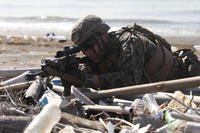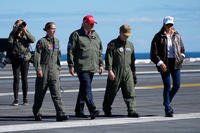Long before he became the last survivor of the battleship USS Arizona, Lou Conter was a hunter.
After surviving the infamous Japanese surprise attack on Pearl Harbor that killed 1,177 of his shipmates, Conter –- who died April 1, 2024, at age 102 –- became a naval aviator and was assigned to Patrol Bombing Squadron 11. The “Black Cat” unit was tasked with hunting enemy submarines at night in PBY-1 Catalina flying boats painted jet black as camouflage against the darkened sky.
Conter was an invisible, nocturnal predator, dropping one-ton torpedoes on Japanese subs in the Pacific and flying more than 200 missions during the course of World War II.
In honor of his legendary career as a naval aviator, Conter's grandnephew, now a Marine aviator, honored his great-uncle’s legacy the best way he knew how: with one final flight.
On April 18, 2024, Marine Corps Capt. Raymond Hower took off in his AV-8B Harrier II not just with Conter’s naval aviator wings -– which he had bestowed upon Hower when the latter earned his wings of gold from the Corps in May 2020 -– but the American flag that would adorn Conter’s burial casket and end up folded and presented to Louann Daley, Conter’s daughter, during his burial ceremony.
“Uncle Lou’s valor as a naval aviator in World War II, especially after the Pearl Harbor attack, earned him the Distinguished Flying Cross, a testament to his heroism,” Hower said in a Marine Corps press release. “So, when I earned my wings of gold from the Marine Corps in May of 2020, it was a profound honor that he chose to pass on his own wings that he earned in 1942 to me.
“Even though he passed away on April 1, there is one final tribute I could offer him: his last naval aviation flight,” Hower added. “Piloting a Harrier that carried the flag that will be draped on the casket of my Uncle Lou was a moment of profound reverence and surrealism for my family and me.”

Make no mistake, Conter’s survival story as a quartermaster aboard the Arizona during the Pearl Harbor attacks is harrowing. But he was also shot down twice during the course of his career as a naval aviator –- and his stories of surviving those shootdowns are as thrilling as the story of his survival of the massive explosion aboard the Arizona.
In September 1943, Conter was shot down off the coast of New Guinea and landed the aircraft in shark-infested waters. His 10-man crew thought they were all going to die. But death would have to wait: Conter instructed his men to “stay together, hold hands and kick slowly, ‘cause there’ll be sharks around … if a shark comes too close, just hit [it] in the nose with your fist as hard as you can,” according to the Maritime Patrol Association.
The men followed his instructions. The entire crew was eventually rescued by a patrol torpedo boat and were back to flying another mission the next night.
The following month, Conter received the Distinguished Flying Cross for a daring series of below-treetop-level rescue flights along Papua New Guinea’s Sepik River, navigating just above the water with minimal clearance on either side of his aircraft. Conter and four other patrol boats would end up pulling 219 Australian coastwatchers to safety, with Japanese troops just a mile away.
“It was one of the biggest rescues in World War II,” Conter later told the Maritime Patrol Association. “But no one knew about it because everything about the coastwatchers was top secret in those days.”
Conter’s second shootdown came a few later In December 1943, when his aircraft was accidentally shot down by friendly fire from a U.S. Army Air Forces P-40 Warhawk fighter while attempting to rescue the crew of a downed B-25 bomber, according to Naval History and Heritage Command. While his nose gunner was killed, Conter and the rest of his crew survived and completed their missions, successfully saving the B-25 crew.

On top of the hundreds of submarine patrol missions he flew during World War II, Conter also served as an intelligence officer and combat aviator, flying 29 missions from the USS Bonhomme Richard during the Korean War. After the conflict, he became the first Navy officer to attend the Army’s Special Operations School at Fort Bragg, North Carolina, and would later develop the U.S. military’s Survival Evasion Resistance and Escape (SERE) training program during the Cold War.
Conter finally retired from service as a lieutenant commander in 1967. He became the last survivor of the USS Arizona after Ken Potts died in April 2023, also at age 102.
“Growing up, I was blessed with the guidance of my great-uncle ‘Lou,’ who stepped into the grandfather role for me, sharing tales of his Navy days, wartime aviation exploits and the pivotal morning of Dec. 7, 1941,” Hower said. “His presence epitomized strength, dedication and modesty, shaping my ideals of manhood.”
Conter died of congestive heart failure at his home in Grass Valley, California. He was laid to rest next to his wife, Valerie, at St. Patrick’s Cathedral Cemetery in Grass Valley on April 23, 2024.
“We could not have gotten through it without the support of the military. The military was such a big part of his life,” Daley, his daughter, said of her father’s passing, according to the Navy. “This was the final salute. We were so blessed to have him for 102 years.”
Want to Learn More About Military Life?
Whether you're thinking of joining the military, looking for post-military careers or keeping up with military life and benefits, Military.com has you covered. Subscribe to Military.com to have military news, updates and resources delivered directly to your inbox.
















